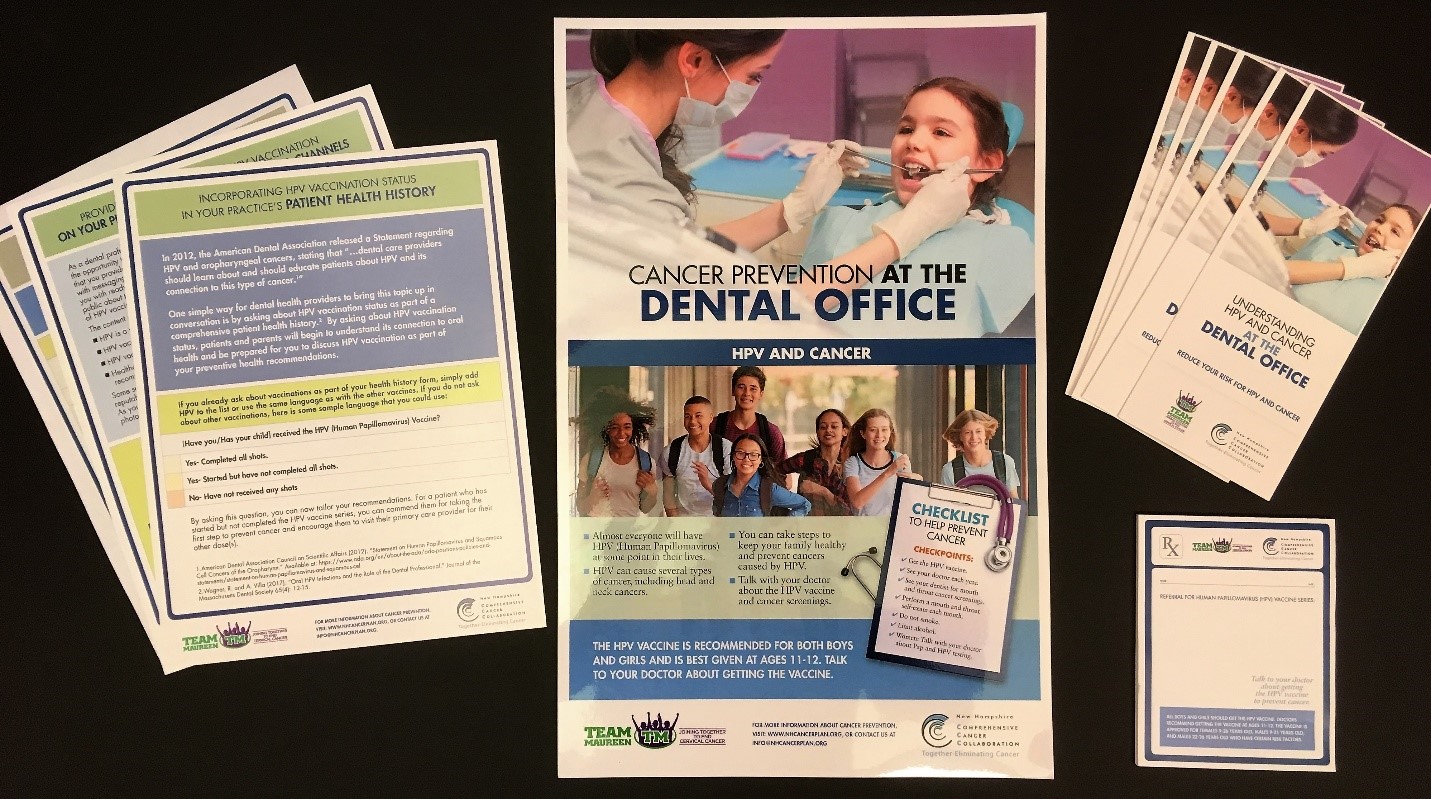Dental care teams play an important supporting role in cancer prevention and early detection. Human papillomavirus (HPV) can cause a variety of cancers, including oropharyngeal cancer. Among cancer cases attributable to HPV in New Hampshire, oropharyngeal cancer is the most commonly diagnosed, especially in men. Unfortunately, the number of oropharyngeal cancer cases attributable to HPV is increasing in New Hampshire among both men and women. Research has demonstrated the HPV vaccine’s ability to prevent oral HPV infection and, likely, HPV-attributable oropharyngeal cancers2,3. However, only 59.9% of New Hampshire 13-17 year-olds have completed this important vaccine series4.
The HPV vaccine is licensed for 9-26 year-old females, 9-21 year-old males, and some higher-risk 22-26 year-old males. Research has found the vaccine provides the strongest protection when it’s given to younger adolescents, which is primarily why it’s recommended to be given to 11-12 year-olds5. Children in this age range generally see their primary care providers less frequently than their dental health provider, and they generally have longer-term relationships with their dental health providers6. For these reasons, it’s important that dental professionals feel comfortable
- asking patients and parents about whether they have completed the HPV vaccine series,
- recommending they receive the HPV vaccine, and
- referring them to their primary care providers to answer any questions and to get the vaccine.
To support New Hampshire dental professionals in these efforts, an HPV toolkit has been developed that includes:
- Sample questions to incorporate into your patient health history form
- Script/talking points to help you recommend the HPV vaccine to parents and patients
- Referral slips to help you refer patients to their primary care providers for the HPV vaccine
- Brochures for parents and patients wanting additional information
- Poster to display in your waiting room, exam rooms, or restrooms to educate patients about the connection between HPV and cancer
- Sample educational messaging to incorporate into your practice’s website and social media platforms
 If you are interested in accessing these materials, please complete this brief order form and questionnaire. If you have any questions about the toolkit, please email NCCC.Community.Outreach@dartmouth.edu.
If you are interested in accessing these materials, please complete this brief order form and questionnaire. If you have any questions about the toolkit, please email NCCC.Community.Outreach@dartmouth.edu.
The development of this toolkit was led by Live HPV Cancer Free (a NH-based working group dedicated to increasing HPV vaccine rates in NH) and Team Maureen, in collaboration with the New Hampshire Comprehensive Cancer Collaboration, the New Hampshire Dental Society, the New Hampshire Dental Hygienists’ Association, the New Hampshire Oral Health Coalition, and several New Hampshire-based dental practices.
1HPV Vaccine Toolkit Available for New Hampshire Dental Offices New Hampshire Department of Health and Human Services, HPV-Associated Cancers in New Hampshire, 1999-2003 Data Brief. 2016: Concord, NH.
2Beachler, D. C., Kreimer, A. R., Schiffman, M., Herrero, R., Wacholder, S., Rodriguez, A. C., … & Jimenez, S. (2015). Multisite HPV16/18 vaccine efficacy against cervical, anal, and oral HPV infection. Journal of the National Cancer Institute, 108(1), djv302.
3Chaturvedi, A. K., Graubard, B. I., Broutian, T., Pickard, R. K., Tong, Z. Y., Xiao, W., … & Gillison, M. L. (2018). Effect of prophylactic human papillomavirus (HPV) vaccination on oral HPV infections among young adults in the United States. Journal of Clinical Oncology, 36(3), 262.
4Walker, T.Y., et al., National, Regional, State, and Selected Local Area Vaccination Coverage Among Adolescents Aged 13-17 Years – United States, 2017. MMWR Morb Mortal Wkly Rep, 2018. 67(33): p. 909-917.
5Petrosky, E., et al., Use of 9-valent human papillomavirus (HPV) vaccine: updated HPV vaccination recommendations of the advisory committee on immunization practices. MMWR Morb Mortal Wkly Rep, 2015. 64(11): p. 300-4.
6Wagner, R. and A. Villa, Oral human papilloma virus infections and the role of the dental professional. Journal of the Massachusetts Dental Society, 2017. 65(4): p. 12-15.